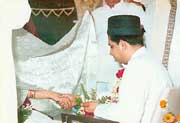Android Apps
These days technology is changing very rapidly. Desktops
have changed into laptops. Soon laptops would be changed to tablets. These days
you can also access internet on you mobile. That’s a great revolution. You carry a mobile most of the time so
internet is finger tips away.
You can also access DesiEvite on your mobile which has an
Android operating system. DesiEvite provides you an App. It is small software
which you can download with ease on you mobile. Once you install it you get an
access to most of the features on your mobile. You would find this App on the
DesiEvite homepage. Now DesiEvite is a few fingertips away.
1-2-3
steps when sending e-card & e-invitation
Suppose your friend lives at some other place. You have to
take a route which has lot of turns. For a couple of times he takes you to his
home. Once he tells you that he is busy and you have to come on your own. Now
you start and get lost. Suppose these roads have sign boards. You call your
friend and ask for important junction. This time when you start you follow
these signs boards and reach his home very easily.
Sending an invitation is a three step process. It includes
selecting an invitation, personalizing it to your need and adding the guests. We
have added a banner which shows you what are doing. It is same as the sign
board. When you are executing the first step it would highlight “Select an
occasion/Event”. Same is true with the remaining three steps. It increases understand
ability and you would be never confused.
New layout and
design in e-invitation page
A house looks mess if it is not designed properly in the
beginning. At the time of designing we also plan the layout of the house like
door would be at a specific place, windows would be at some other place. When
the house is completed it looks perfect.
We have separated the invitation from the other
functionalities. Now you would see the whole invitation in half pane. The other
halve would display the other functionalities like Guest response, editing an
invitation and sharing photos of the event. It gives a great look to our interface and increases
readability.
Adding Indian
wedding information in Blog
DesiEvite runs a blog service which is integrated in the portal.
You would find a lot of wedding related blogs belonging to different culture. It
is updated frequently every week. Please visit the page and find out more about
the diverse culture of India. If you want to include a blog belonging to your
area you can submit a request. We would love to post it.
Visit Business directory search
page
DesiEvite provides party services & business promotion
facilities/option to all party services & business, who would like to
promote their business on this popular social media platform. For this purpose
it has made an online directory called Party Resources Directory. A user can
got there and search information like wedding party hall, wedding items and
gifts. In addition to that if a user wants to promote his business he can add
an ad for free. The search page works
like the google or yahoo search engine. Please visit the page and take a look
at this robust feature.
Latest designs in both e-card &
e-invitation
We keep adding new designs to e-card & e-invitation
categories. The categories which are constantly updated are birthday and
wedding. Other categories are also updated on a regular basis so that the user
has enough options to choose. We have also added sub-categories to the designs
so that a user can find the design which suits his needs very easily. You just have to keep visiting these
categories. You can also submit a new design request if you need one.
Better user support
One of the goals behind running the site is to provide user
with the upmost satisfaction. It should be a two way process. We invite the
user to provide us the feedback so that we can improve. We give the feedback
the highest priority. We are constantly
sending e-mails to know their view on the whole process. If it has not landed
into your inbox, it would be there soon. We also invite them to provide us with
the enhancements they would like to see. We have also added some of the
requests from the users like, the user can import the contacts from the excel
file.
Gmail Contact
Importer
This functionality lets you import or transfer all your
gmail conatcts to your guest list and if you have checked the other
functionality “Add to address book” it gets added into DesiEvite address book.
Next time when you return you have to open you address book and add guests to
your invitation directly. It saves a lot of time and effort. For the time being
it works with internet explorer only. You can concentrate on your invitation
design and customization. It is a nice
feature to have and fall in love with.
Please be in touch with desievite to get more
updates.







































